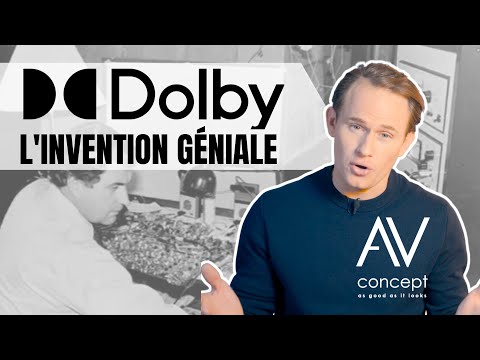DOLBY : L‘Homme derrière le nom

Today we are going to talk about a brand that you all know, without actually knowing it. More than a brand, its logo is the symbol of a promise to live an audio experience and today, even video, of high quality. Because behind its logo hides a man and a story and both are ultimately inextricably linked by a name. So, instead of making yet another video on new sound formats and Dolby news , we're going to dive into the story of its roots and therefore naturally that of its founder: Ray Dolby. Genius inventor, high-flying engineer and peerless entrepreneur, Ray Dolby forever marked the history of sound and the way it is heard today. In this video, I will also share with you the name of another man without whom the Dolby company we know today would certainly be very different. So, before we
get back to the inventions and contributions of the man behind the name, let's first pick up his story from the beginning. Before going any further, let me clarify that we are neither sponsored by Dolby, nor do we own any personal or corporate shares in him. Ray Dolby was born January 18, 1939 in Portland, Oregon. A brilliant student, these studies led him to study at Stanford and his outstanding skills earned him notice very early on, since at barely 17 years old, Ray Dolby already worked at Ampex during these summer jobs. And it was clearly not
to bring coffee or to make photocopies. To re-situate you, Ampex was a pioneer in the field of magnetic tapes, both for sound and image. Unfortunately, like other ultra-specialized managers of the time, she did not know how to reinvent herself and evolves with the times. We will come back to that in a few moments. Coming back to Ray Dolby, it was there that he made his first sparks, since he helped create what was then the first VCR in history. And for the youngest people who watch us, the
video recorder is the ancestor of the blu ray player and the dvd player. It was before streaming what. It looked like this or that. But since Dolby's was the first machine, it was even bigger and it looked like this. And there you see the young Dolby, right here. Its role is recognized as major in the development of the device. It's pretty good for an 18 year old kid. The irony of the story is that Ampex actually didn't quite know what to do with this recording machine. They thought they could sell one or two pieces of it to
big studios and TV channels, to broadcast delayed programs across the United States. It is therefore without doubting a moment of the revolution of recording and broadcasting content at will, was going to be for the world a few years later. Like what, the vision there we do not have. And the least we can say is that Ray Dolby, the vision he had. After completing his studies at Stanford, he joined the army and continued his studies in Cambridge, from where he left for a while, to join the United Nations in India, as a technical advisor. It was once back in Cambridge that
Dolby's appeal for entrepreneurship ended to develop. And like any entrepreneurial adventure, it all starts with a problem to solve. And here's the one from Dolby. One of Ray's hobbies is making music recordings. He went to the Great Chapel in particular, to record the choirs of Cambridge University. But each recording is marred by a background hiss, audible on each tape. He is then increasingly
interested in the problem and how to solve it. Especially since this problem, he is not the only one to have it, but literally every music recording that we bought at that time had this annoying background noise, which spoils the listening. As you can see, Dolby is not the first to raise the problem, since engineers have been racking their brains for a long time to find a solution. Dolby first accepts that the hissing problem
cannot be resolved after recording, but that the sound signal must be processed upstream, during recording. And here is his solution. It first detects the frequencies responsible for the background noise. These are more localized in high frequencies, high pitched sounds . Then it then emphasizes the entire signal, emphasizing the overall signal. It emphasizes even more the high frequencies, which thus become perfectly localizable. It then acts with a system of filters, which will simply remove the frequencies which correspond to the insertion of the background noise in the band. The signal is then boosted
to return to normal. And that's how the magic works: Dolby succeeds where so many others have failed. The process was simple, elegant and efficient. So on the basis of this process, Ray Dolby, 26, started his business in 1965. And that's what allowed me to understand
why this native American came to found his company in London. It was because of his studies that had brought him here. Day will call the first noise reduction device Dolby A-Type. The bottom line here is that Dolby is not a solution that can be applied to just any source at the time of listening, but it is a system. A system that requires encoding on one side and decoding on the other. And this is the meaning of the Dolby logo. The first D encodes while the second decodes. Simple, elegant, efficient. The other thing to
remember in this is that Dolby is above all a business geared towards companies and not users. Dolby sells its noise reduction devices to recording studios, which pass the profits on to their customers, who buy the records. But as time tends to lose the relief of events, remember that at that time the Dolby laboratories were still in their infancy. And Dolby had borrowed money from his parents to start his business. A year after the creation of the company, and after a lot of effort and traveling to meet engineers, Ray finally managed to sell his first six machines to the Decca Records studio in 1966. In an interview, Ioan Allen, the one of the first
partners and vice-president of the company, remembers the design of these machines. From the start, Ray Dolby wanted a system that worked like magic, with no adjustments, no buttons. Just a big box, in which to pass the sound so that they find themselves cleaned of all unpleasant noises. To believe that others were inspired by that later in the story. Again, it was simple, efficient and elegant. The hardest part of finding
new clients is evangelism. Succeed in convincing new clients who are by nature cautious about change and do not want to be the first to wear the plaster. In short, it is the snake that bites its tail and the teams must redouble their efforts and energy to convince prospects. But efforts pay off. In 1969, Dolby Laboratories, after a healthy and constant growth with already a hundred machines sold. At that time, the company primarily targets recording studios
specializing in classical music. Indeed, Dolby machines are expensive and only classical music studios are able to invest in this type of system. They are also the ones who have the customers asking for better listening quality. But the musical revolution will turn a corner and give a major boost to the company. The end of the 60s and the beginning of the 70s marked the advent of rock in popular culture . And with it, of course, the desire to listen to better quality. And this is what will propel Dolby into its first real success. So you will tell me, how would
Rock N 'Roll make more money than classical music? At that time, Dolby was selling machines and not licensing, so no recurring revenue generated with each sale of records. So there is no income that grows with record sales. Well, as in any cultural revolution, behind this musical revolution hides a technological revolution. Because where classical music is recorded with one or two microphones to obtain a sound image of an entire orchestra, rock is recorded by instrument. And each instrument represents an audio track. Dolby A device supports two audio tracks. One is therefore sufficient to record an orchestra. Rock songs are often played on 16
tracks. And the accumulation of these 16 tracks with background noise makes it all the more audible than on a two-track classical music mix. We summarize: 16 tracks to process, instead of two is a problem even more apparent than on a two-track mix. This is the jackpot. The Dolby process becomes essential to clean multitrack music. The company now sells
eight devices capable of handling 16-track processing, instead of a single device, for two-track classical music. Best of all, the artists don't go to just one studio. To record their album, they cross countries and continents, to record in different places. What made the first studios cautious ultimately becomes what makes them seekers and prescribers of the system. Competition pushes everyone to offer the best results to their artists. Those who have not yet heard or used, discover the performances of Dolby A, thanks to the artists who visit them, with under the arm the copies recorded in a studio equipped with the technology. The magic now operates on its own.
As a result, in barely 18 months, the main studios in the Western world are equipped with a Dolby noise reduction system. In 1972, in London alone, 42 aircraft with 16 tracks were in operation. But this success with recording studios, Dolby knows it will not be forever. The democratization of magnetic tapes and audio cassettes is already in the making. As early as 1969, Dolby therefore created a more affordable, less sophisticated version of
its noise reduction system: Dolby B-Type. Although it is much less powerful than Dolby A-Type, Dolby B-Type can be implemented directly in almost all magnetic tape players . The decoding is therefore done directly on the consumers' cassette players . And unlike Dolby A-Type, Dolby B-Type certainly requires a suitable decoder in the player, but the sound produced by a device that is not equipped with the technology still offers decent sound. Dolby's stroke of genius will be to sell only the encoding system
to recording studios. Then to give access to decoding, free of charge, without license fees to the manufacturers of cassette players. Dolby is starting to become popular with the general public. But, you know it better than anyone, today Dolby is certainly known for sound, but especially for cinema sound. And this is where Dolby takes the next step. And that would certainly not have been without Ray Dolby and his teams but not either - and that, we know the least - without Ioan Allen.
The rate of equipment in Dolby material in recording studios is beginning to saturate its own market. And it is Ioan Allen who will set the new course for an industry that requires as much, if not more than that of music, better audi quality. I speak of course of the cinema. At that time, the sound of films was recorded in the form of audio tracks , which were superimposed on magnetic tape. Basically, the dialogue, the special effects, the music,
all these essential elements of a movie are put together to make the soundtrack. In short, just like rock recorded in multitracks, the films of the time did not escape the problem of background noise. And with hundreds of productions coming out each year, what better opportunity for Dolby, than to solve the same problems they had solved for the music world. But now, the cinema market requires even more effort than those of recording studios to enter. And the operation is even more expensive. It will therefore be long and tedious. It is here that Ioan Allen will first bring
the company something to move in this direction. Having previously worked with the music industry, one of his contacts is called Wendy Carlos. Wendy Carlos is one of the pioneers of electronic music. And Stanley Kubrick called on her to produce the soundtrack for his next film. Wendy, who was still called Walter at that time, but that's
another story, was an absolute fan of Dolby's noise reduction system. This is how, in 1971, the first film shot with Dolby noise reduction technology came out in theaters: A Clockwork Orange . It's pretty good for a start. But it was not until 1977 that the success really became global. Since this is where an unsung young director is about to release a bit of a weird movie, the title of which will probably mean something to some of you. It's a story of chivalry, but it takes place in space. I'm obviously talking about Star Wars. And the peculiarity of this film is that it is not only made
with a background noise-free, but it is above all the first to offer an immersive spatialization , completely new for the time. Then shortly after, Apocalypse Now will be released. It will be the first film to offer 5.1 sound as we still know it today. This period, Dolby is also improving in its marketing. Because that's when he had his logo affixed to content and cinemas that offer Dolby technology. This is how this logo, which we all know today, truly became ubiquitous on film posters and cinema storefronts In short, it was during this period that the general public really began to become aware of the added value of Dolby-labeled content.
And the success of Star Wars made a giant leap in the development of the company. Since in just a few weeks of film screening, nearly 300 cinemas are converted to meet standards, in order to be labeled Dolby. To be labeled Dolby, cinemas must follow and respect strict specifications. This is what guarantees an experience of the same level, in each room that offers the system. And that's still how it works today. The specifications, both for large cinemas, and
in the arrangement of recommended speakers for home cinema are strict and not necessarily easy to follow. But it's always with the ultimate goal of bringing the best experience to spectators. With this diversification, the brand becomes ever more well-known and recognizable. At the same time, an ever larger audience feels the need to view content with ever more quality, at home on its color TV. Just like with Dolby B for noise reduction , the company is adapting the decoding of multi-channel movies, so that they can be played at home, with the effect first discovered in theaters. Ioan will be the man behind the major innovations in cinema sound for the next 30 years. It will be he who will bring the vision, to further improve the immersion experience in cinema. The film distribution market is a never-ending race to offer ever more
immersion and quality to viewers. And as soon as a technology becomes accessible to the general public, a new more sophisticated still invades the cinemas. The job is to continue relentlessly to carry the innovation that will make you want to come to see films in the cinema, then to miniaturize it so that it can be reproduced at home. Dolby will thus release
many more versions of its multichannel. First in analog, then in digital with Dolby digital. Dolby will then add surround channels with Dolby EX and Dolby 7.1 in 2010. But their commercial success will remain limited. The next bet won will be launched in 2013, with Rebelle as its first film. Dolby Atmos offers an unprecedented sound immersion experience. In short, Dolby
Atmos is the passage of sound from 2d to 3d, while moving to 4K. Since the sound can now be localized in three dimensions, with a granularity never before achieved. This technology is called sound per object. So, whether in the cinema or at home, the speakers that are added with Dolby Atmos provide more precision in the action and not more power. As I record this video, Atmos technology is arguably the most widely used object sound technology. It can be used for movies as well as for concerts or simply music albums. But despite the undeniable success of the Dolby Atmos process, it still took nearly 10 years to deploy and become known to the general public. As you can see, these innovations take place over a long period of time. Because even if
Dolby Atmos says something to more and more people, I realize the number of people who come to the showroom and discover the Atmos experience for the very first time with us, then at home with our facilities, the question What fascinates me now is what is the next evolution that will arrive in our cinemas. And then in our living rooms Dolby Laboratories were listed on the stock market in 2005. They are valued at more than $ 9 billion. And with offices on 4 continents and over 2000 employees it takes its top form Dolby technology is absolutely everywhere and you use it without even knowing it. The phone, tablet or computer that you use to watch this video works with Dolby codecs in particular. With Dolby vision technology in particular, Dolby
now offers a complete ecosystem of technology processes from sound to image. Enough to ensure an extraordinary grand spectacle experience. Dolby's secret sauce can finally be summed up by these few points: manufacturing devices for professionals in-house; but have consumer products manufactured under license without ever competing with these manufacturers; bring value to professionals so that they transmit technology by themselves to the general public, without ever forcing them; and ensure that licensees affix the logo and therefore do the communication for the company: with each innovation, bring a notable improvement for anyone, so no half measures; and finally to demand the respect of the strict rules of the licensees in the implementation of the technology, so that the user is certain never to be disappointed. The taste for simplicity, performance and quality have enabled Dolby to leave an indelible mark in the history of sound and image and the way the world enjoys audio video content. Just like Walt Disney did. would never have built the empire we know without his brother Roy, who worked in the shadows, Steve Jobs without Steve Wosniak, or Bill Gates and Paul Allan, Dolby's success in the film industry is largely due to work of Ioan Allen, who admittedly less known to the general public, has been able to extend the applications designed by Ray. It is ultimately the combined genius of these two men that allowed the company to
become what it is today. You understood it, the goal today was not to tell you about all the innovations of Dolby, so I put aside a lot of them, to share with you the less known part of the adventure. I hope I have lived up to the tribute I wanted to pay to this company and these two men. Just as I hope you enjoyed watching this video, as much as I enjoyed preparing it. Thank you for staying with me until the end and for being more and more to follow us every week. This is probably
the video that has required the most time and research to date. So if you liked this format, think about liking this video and sharing it around you and obviously subscribe, so that we can meet again next Friday. Finally, I'll leave you with a last excerpt from Ioan Allen's interview, which will make some of you think about using bass and surround sound. I leave you now, take care of yourself and see you soon!
2021-01-01 03:30


